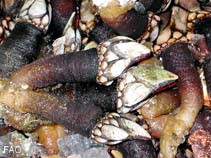Pollicipes pollicipes (Gmelin, 1789)
Stalked barnacle| Native range | All suitable habitat | Point map | Year 2050 |

|
| This map was computer-generated and has not yet been reviewed. |
| Pollicipes pollicipes AquaMaps Data sources: GBIF OBIS |
Классификация / Names народные названия | синонимы | CoL | ITIS | WoRMS
Thecostraca | Pollicipedomorpha | Pollicipedidae
Environment: milieu / climate zone / пределы глубины / distribution range экология
; пределы глубины 0 - 200 m (ссылка 356). Subtropical, preferred 19°C (ссылка 107945); 50°N - 15°N, 19°W - 6°E
Distribution страны | регионы FAO | Ecosystems | места находок | интродукции
Northeast Atlantic and the Mediterranean.
Length at first maturity / Size / Weight / Возраст
половая зрелость: Lm ? range ? - ? cm Max length : 12.0 cm TL самец/пол неопределен; (ссылка 101388)
Life cycle and mating behavior половая зрелость | размножение | нерест | Eggs | Fecundity | Larvae
Основная ссылка
ссылки | координатор | соавторы
MarineSpecies.org 2050 MarineSpecies.org. http://www.marinespecies.org/index.php (ссылка 3477)
Статус Красного Списка МСОП
(ссылка 130435: Version 2025-1)
Статус СИТЕС (ссылка 108899)
CMS (ссылка 116361)
Угроза для людей
Использование человеком
рыболовство: коммерческий
FAO - рыболовство: landings | FishSource | Sea Around Us
инструменты
дополнительная информация
состав пищи
потребление пищи
хищники
Max. ages / sizes
Length-weight rel.
Length-length rel.
Размерный состав
Mass conversion
численность
ресурсы в Интернет
BHL | BOLD Systems | CISTI | DiscoverLife | FAO(рыболовство: ; publication : search) | Fishipedia | GenBank (Геном, Нуклеотид) | GloBI | Gomexsi | Google Books | Google Scholar | Google | PubMed | Tree of Life | Wikipedia (Вперёд, поиск) | Zoological Record



